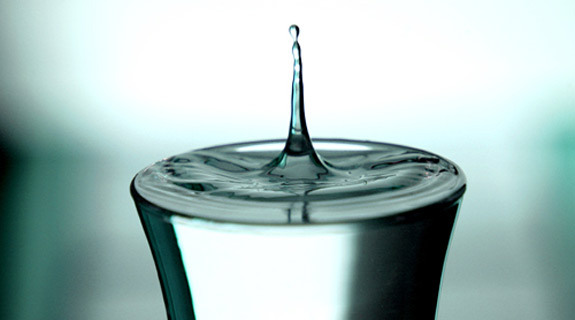Fresh water is a precious resource, so it’s handy that so much of it falls out of the sky in New Zealand. All we need to do is collect it
Fresh water is a precious resource, so it’s handy that so much of it falls out of the sky in New Zealand. All we need to do is collect it. Rainwater harvesting is one of the easiest ways to add a little self-sufficiency to your life, writes Andy Kenworthy—and it could save you money
Photo from www.flickr.com/photos/darkpatator/ / CC BY 2.0
Most parts of New Zealand have a pretty good supply of fresh water, but it’s not always in the right place at the right time. Mains water storage dams, pipes and treatment facilities come with environmental impacts and costs, and the mains system is subject to seasonal restrictions and maintenance that can leave you, or at least your precious vegetable patch, high and dry.
Even small roof water systems can take a huge load off the mains supply and help slow the flow of water in urban areas, improving storm water management and reducing the risk of flooding.
The numbers
Each person needs five litres of drinking-quality water a day for cooking and drinking. Each of us uses about another 160 litres a day for flushing toilets, showering, clothes washing, and in the garden.
As a rough guide, you can collect about a litre of water for every millimetre of rain that falls on every square metre of your roof in an average year. Even in relatively dry districts, an average home with a roof area of 120 to 150 square metres has the potential to collect at least 100,000 litres of free water each year. To supply all its water, a smaller household could get by on a 25,000 litre tank. A larger household may need two.
Unless you have a lot of roof, a lot of rain and plenty of tank space, or you are very frugal with water use, you will probably want to keep mains water back-up. Many councils still charge a standard water rate. Different councils calculate this in different ways, and your rate may or may not relate to how much water you actually use. Some offer the option of switching to metered usage. It costs between $500 and $1,000 (sometimes more) to get a meter installed, plus a couple of hundred dollars a year for water testing and meter reading.
Even taking that and the cost of installing a roof water system into account, if rain meets all your water needs the savings are likely to pay back your investment in about ten years in most locations around the country.
Watch out for …
Cleanliness: Keep the roof and guttering clear of overhanging branches. Regularly inspect and clean guttering, and consider fitting a filter. The Ministry of Health recommends disinfecting roof water with small amounts of chlorine, but if you dislike that ‘fresh from the swimming pool’ taste, an ultraviolet light filter system costs about $1,500, plus installation.
Contaminants on the roof: Unplug the roof system if you use chemical paints or moss killers up there. Don’t collect rainwater from an unpainted metal roof or one where lead, chromium or cadmium materials are used. Any roof paint should be labelled ‘suitable for potable water supply’.
Your intake: Rainwater is naturally ‘soft’, meaning it doesn’t contain the dissolved minerals (such as chalk, lime, calcium and magnesium) that percolate through the ground into our waterways and mains water in some areas, which are important for our health. Nor does rainwater contain the fluoride that’s added to some public water supplies to reduce tooth decay. It’s worth taking dietary—and dental—considerations into account when deciding to switch to rainwater.
Small people: For the same reason, as well as the risk of possible contamination, some doctors advise that even filtered rainwater may not be ideal during pregnancy or for bottle-fed babies.
The paperwork
You may need a minor plumbing consent from your council, or a building consent for a tank over 25,000 litres.
You will also need to fit a backflow prevention device if your tank is being topped up from the mains supply, to keep the two types of water separate. If you plan to drink roof water, some councils require you to treat it. Others require an annual inspection of your system.
On the plus side, some local authorities offer cash rebates to encourage rainwater use.
GETTING STARTED
A simple water butt connected to a downpipe is great for your garden or indoor plants. Sit it on a plinth about a metre high so you can fit buckets and watering cans underneath, and use it for low-pressure hoses or irrigation systems without a pump. Keep the lid on to prevent mosquitoes breeding.
Price: $185, including a tap and a diverter unit (excluding freight)
Capacity: 209 litres
www.rainsaver.co.nz
SMALL SCALE
If you want roof water only for outdoor use and to flush your toilet, consider a tank from tanksalot.co.nz. You can customise their shapes, and they are made out of good-looking corrugated steel in your choice of colour. Include a pump and something like a RainBank device, which allows the priority sourcing of rainwater for toilets and laundry, using mains water only as a back-up (available from www.watersmart.co.nz).
Price: About $3,500 for tank (depending on size and finish), $550 for stainless steel jet pump, $1,640 for RainBank 2. Total: $5,690 (excluding installation)
Capacity: 5,000 litres is ample for this job
www.tanksalot.co.nz
www.watersmart.co.nz
BIG TIME
The easiest way to supply all your water is to install something like the Davey Aquashield MAX UV System, a combined pump and water treatment system for getting drinkable water from your roof. You may also want to include a first flush system to divert the initial flow from a rainfall, which can potentially be contaminated.
Price: $3,500 for tank, $5,000 for combined pump and treatment system, $500 for first flush system. Total: $9,000 (excluding installation)
Capacity: 25,000 litres is enough to fully supply a small household
malmakswatershop.co.nz
THE NEXT BIG THING
The Eco-Sac is essentially a gigantic version of those water bladders sports folks wear on their backs. They come in a range of sizes and easily fit into almost any space, including under the floor. When you move they can be packed up to go with you.
Price: $2,500–$3,400 for bladder, $2,100 for pump and back flow preventer valve. Total: $5,500 (excluding installation)
Capacity: 1,700–8,600 litres
www.newwater.co.nz





